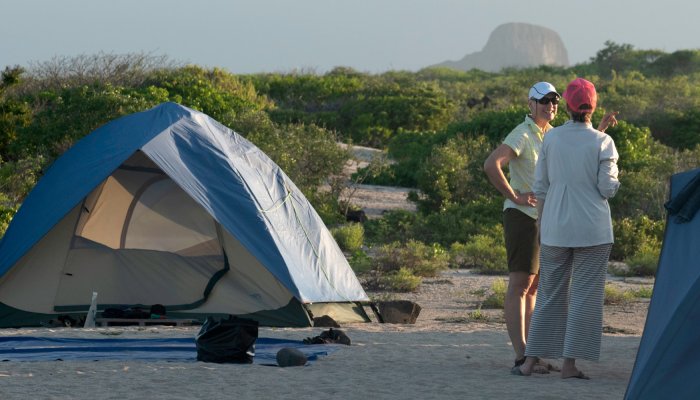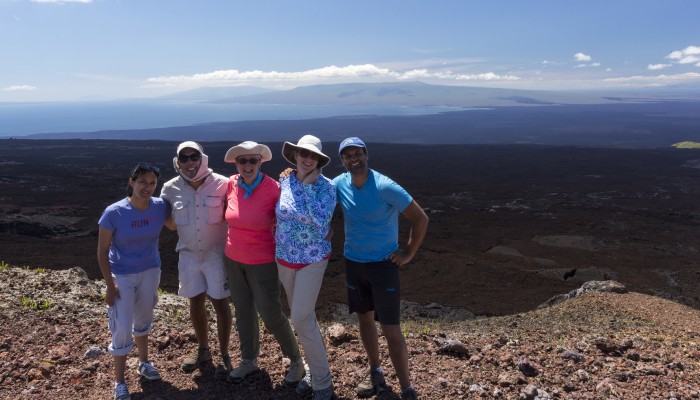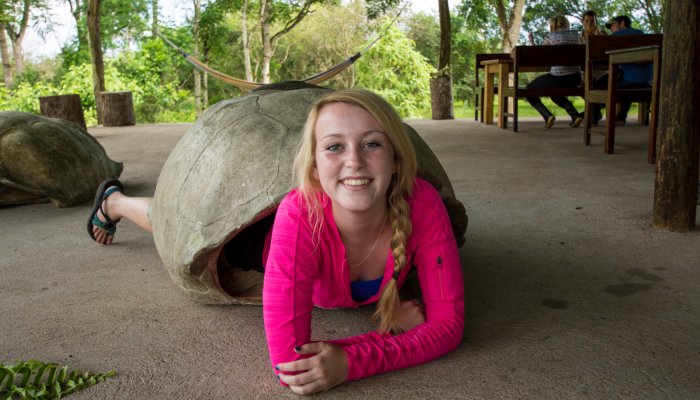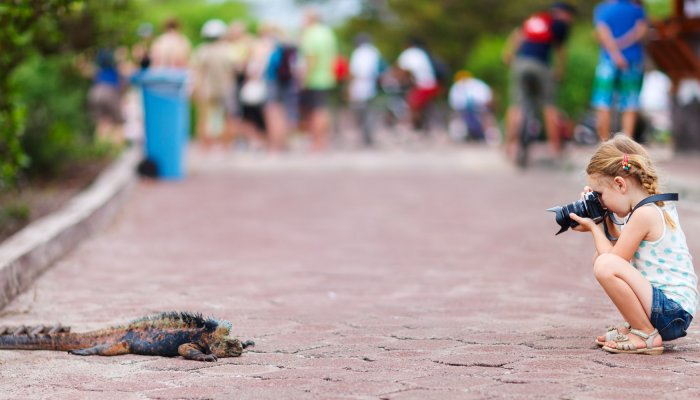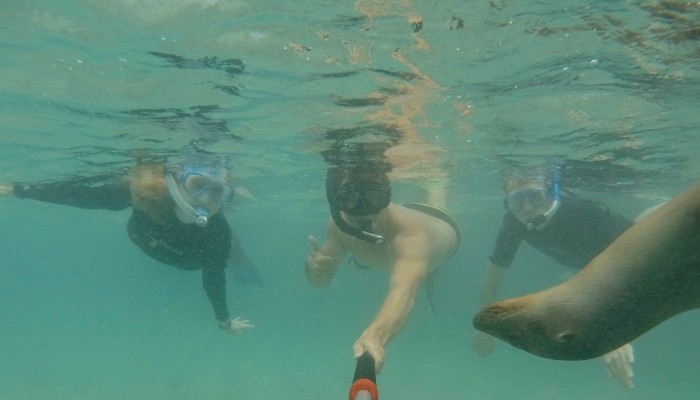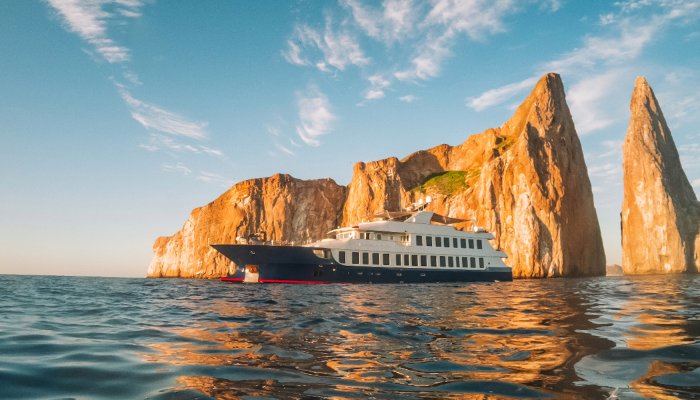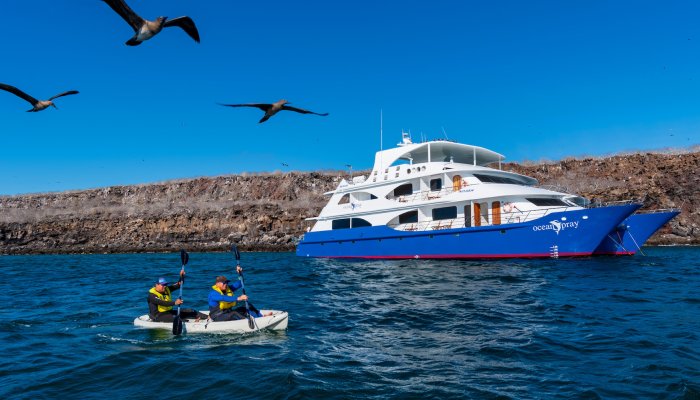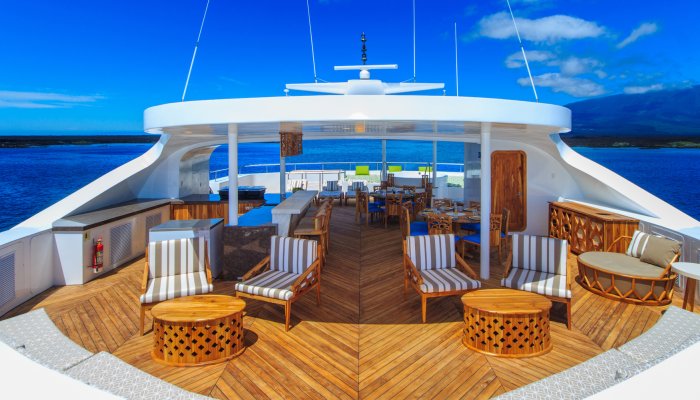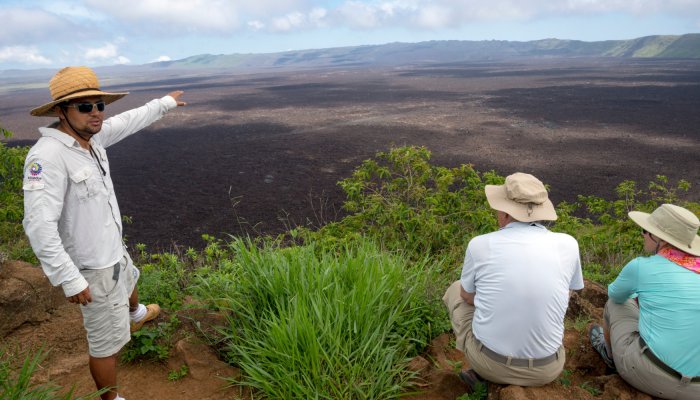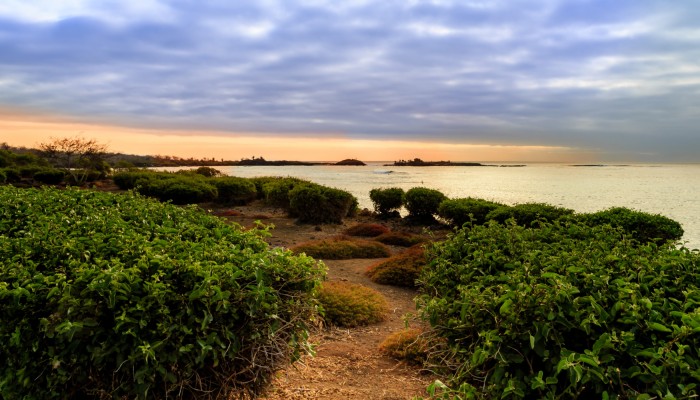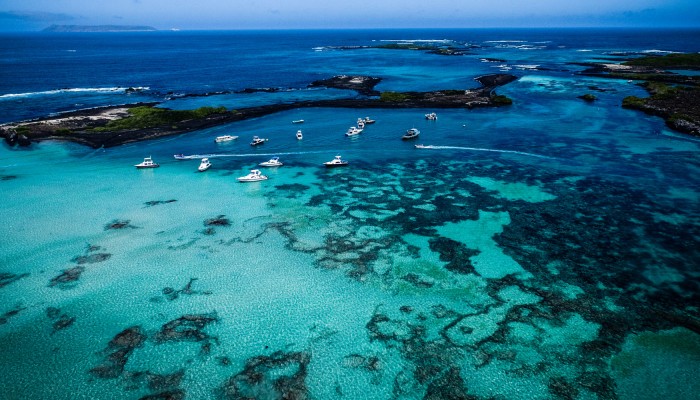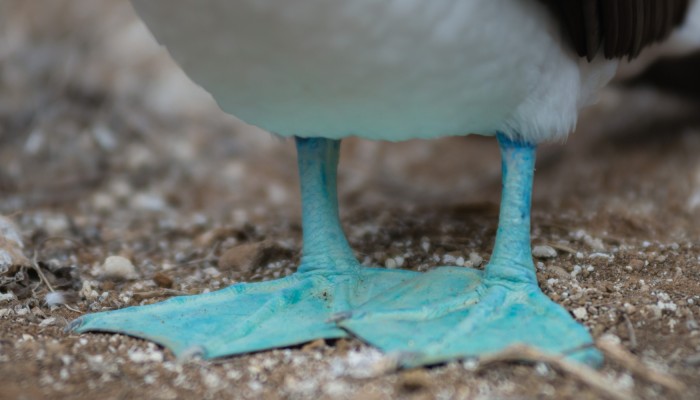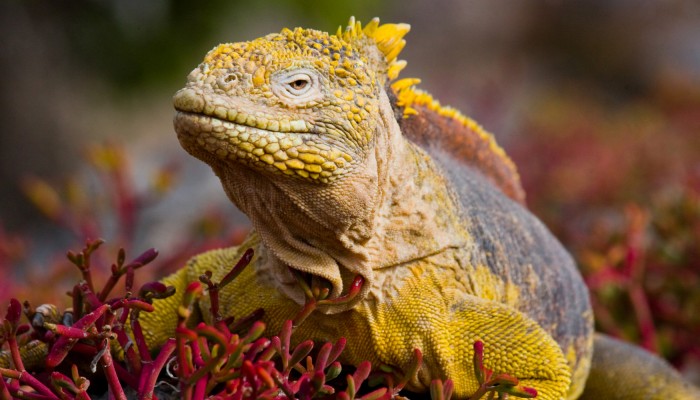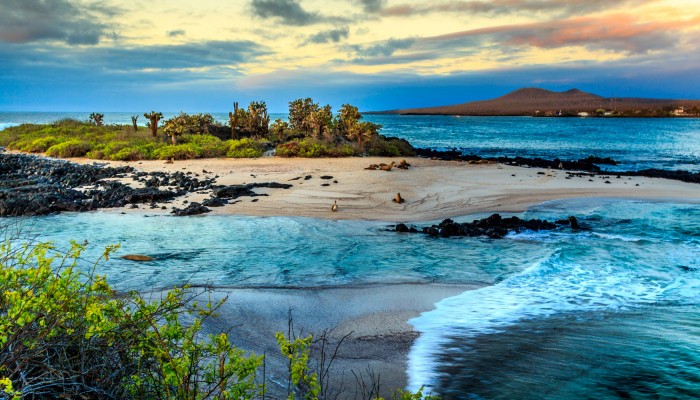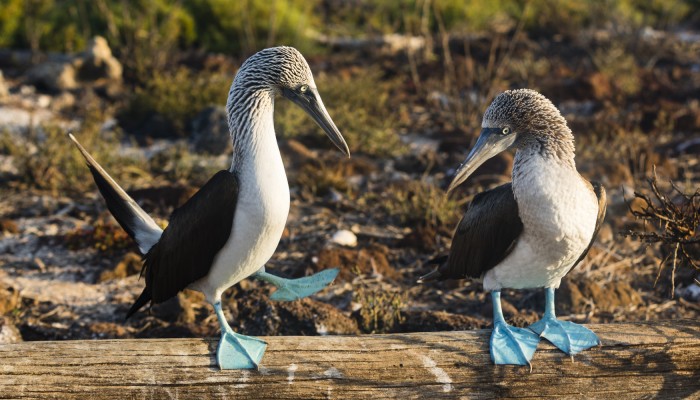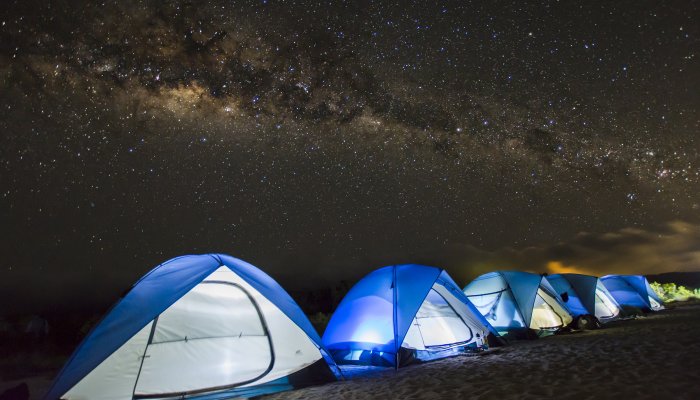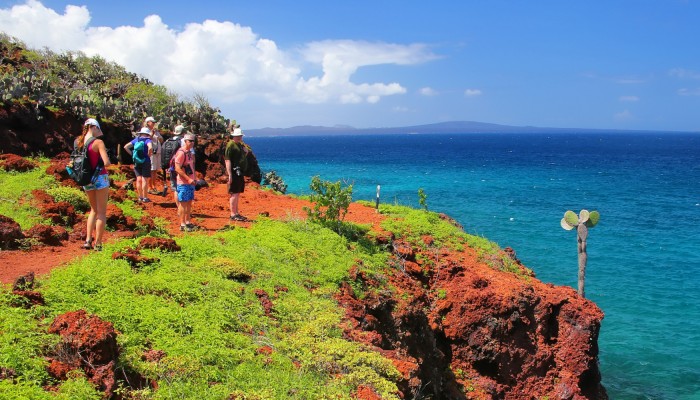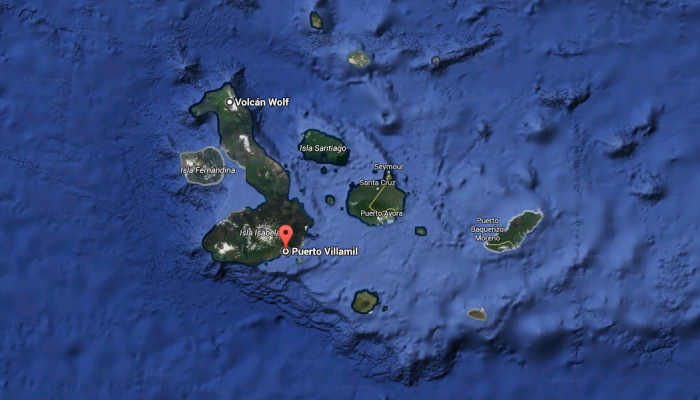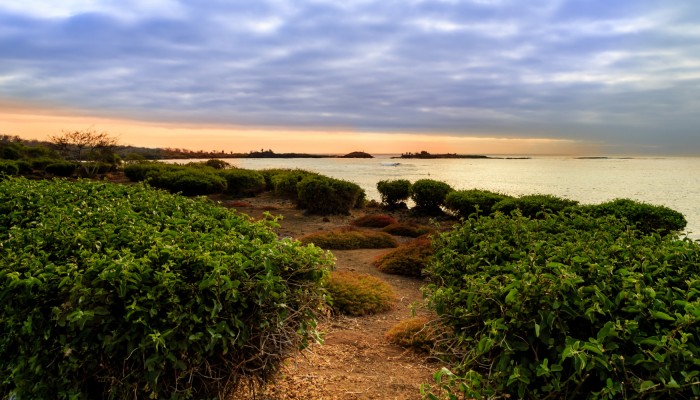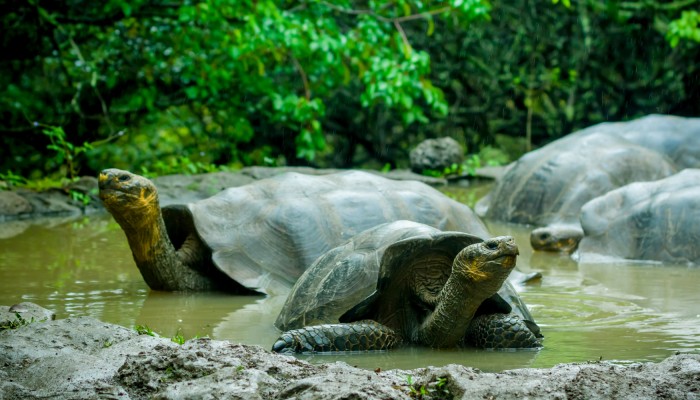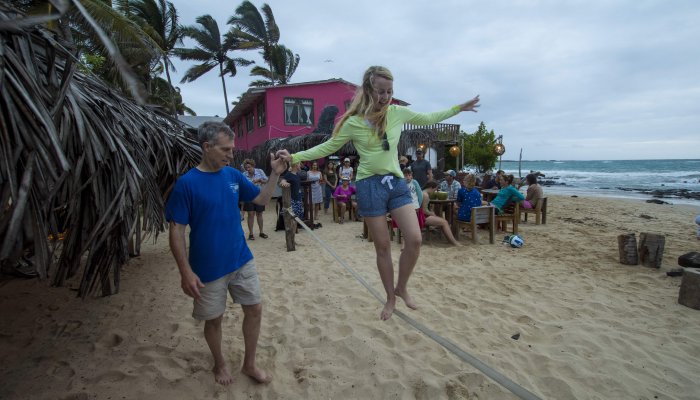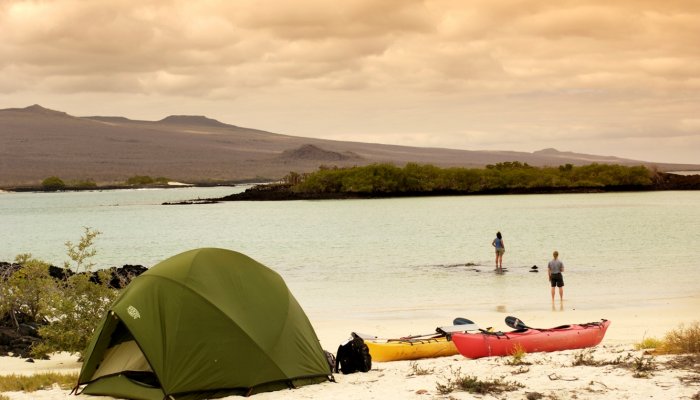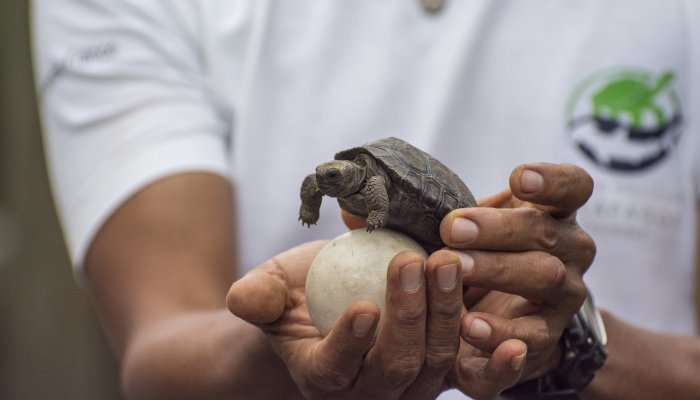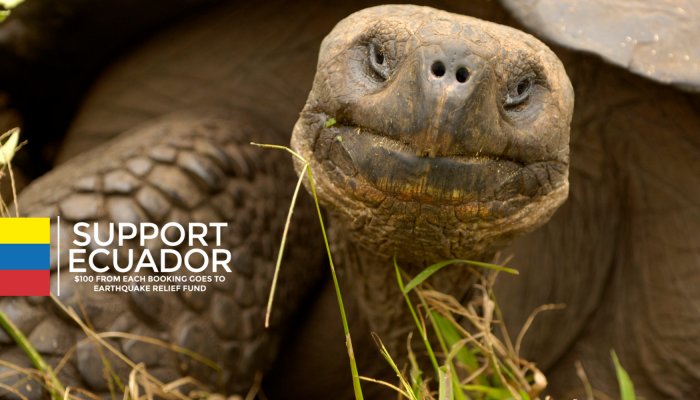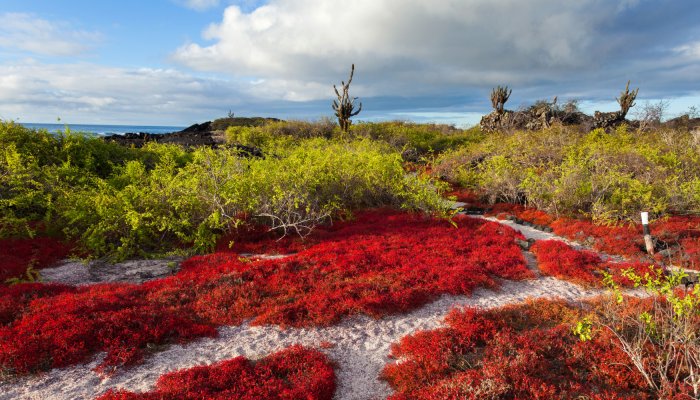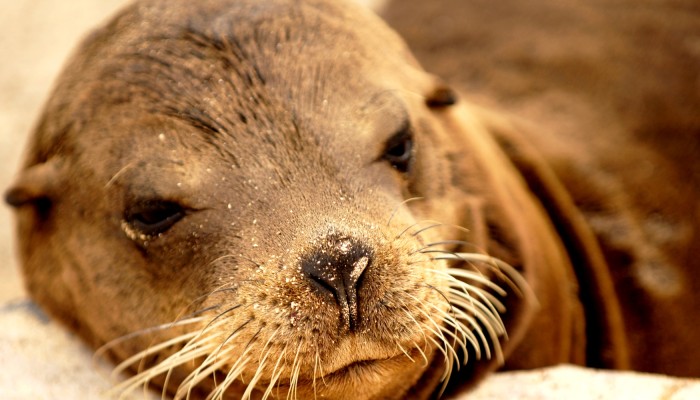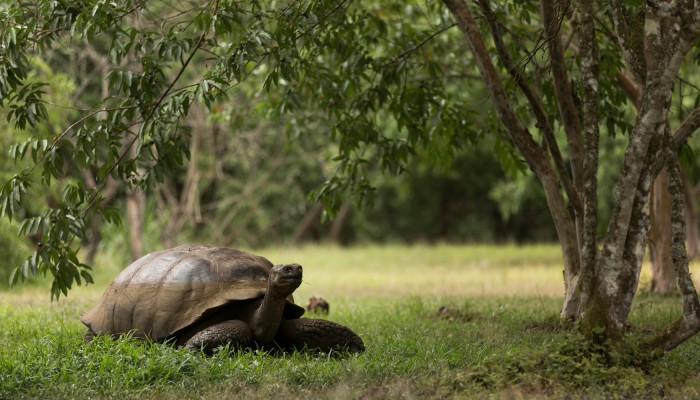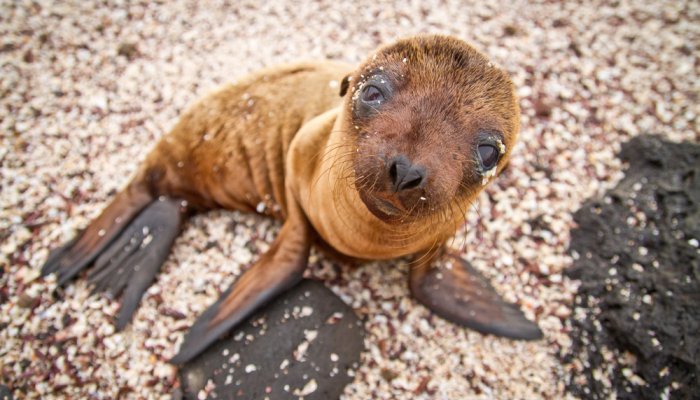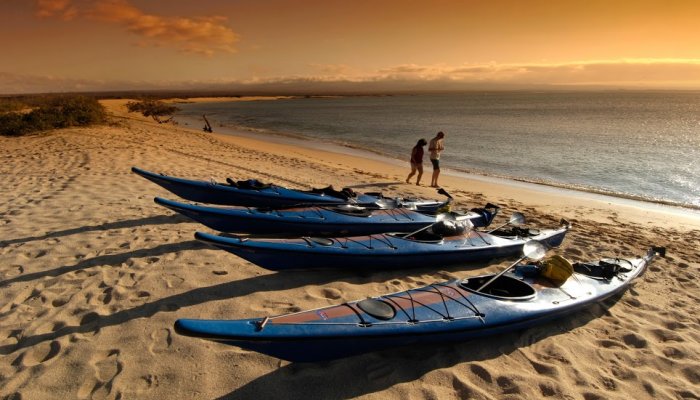Overview
Perhaps the most dreamworthy destination for wildlife enthusiasts, the Galápagos Islands continue to be one of the world’s most iconic destinations. This protected paradise is home to gigantic Galápagos tortoises, blue-footed boobies, pink flamingos, Darwin Finches, marine iguanas, and so much more. Friendly wildlife wanders freely throughout the islands, allowing for enchanting up-close contact with seemingly storybook creatures.
With Adventures Unbound, you are able to get up-close and personal with the archipelago in a way that no other tour operator can. We are proud to have an exclusive permit to camp on the islands, and permission to sea kayak, snorkel, and hike where others cannot. We also visit small villages where we spend quality time getting to know locals, making for a meaningful people-to-people experience often overlooked by major tour operators. Leave the crowds behind, step off of the main tourist routes, and experience the real Galápagos Islands with Adventures Unbound!
Our Trips
Custom Tours in Galápagos
With Adventures Unbound, discover the Galapagos Islands magnificent nature and wildlife by foot or by paddle led by expert local tour guides who know the country’s landscapes, history, and flora and fauna like the back of their hand. Explore the picturesque coastlines and lush interior of the Galapagos islands in a more customized and intimate travel style.
Working closely with local partners and affiliates in the Galapagos, let us curate a private tour that reflects your interests, whether it’s scaling mountains, relaxing sea side or discovering new cultures. All of our customized tours in the Galapagos include delicious local cuisine and comfortable accommodations.
To get started, please fill out the form below, or you can learn more by reading some of our most frequently asked questions.
Image & Video Gallery
Country Guide
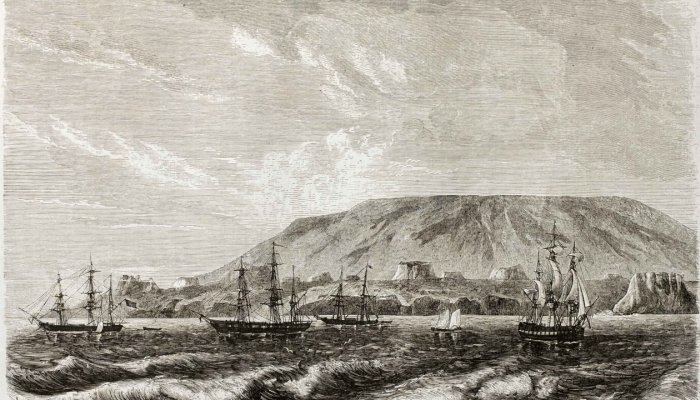
History of Ecuador
Ecuador's history has often been volatile and violent. It has continually struggled with sustaining stable sociopolitical institutions, and has had continuous economic, and geographic obstacles. The indigenous people saw various cultures rise, fall, and converge before the Incan and later the Spanish conquests. Since Ecuador’s declaration of independence from Spain in 1822, they have experienced over 90 overturns in power and, on average, face a new military government or civilian government every couple of years.
Indigenous Ecuador Before the Inca
The Valdivia people, one of the oldest cultures in the Americas, occupied the Santa Elena Peninsula over 5500 years ago, and are recognized as creating Ecuador’s first stable settlement and non-nomadic culture. Around 600 BC, Ecuadorian societies started developing. Their social systems became more stratified with castes of shamans and a distinct merchant class that conducted long-distance trade with other South American cultural groups between Ecuador, Peru, Brazil, the Amazon, and later Mexico.
The Incan Empire
The Inca struggled in their conquest of Ecuador and eventually attempted to gain power through marriage and fathering a son, Huayna Capac, who ruled between 1493 and 1525 and conquered the remainder of Ecuador, killing all men and boys aged over 12 years and throwing their bodies into a lake which today bears the name of Laguna Yahuarcocha, which means "Lake of Blood". They imposed Quechua, the Inca's language, which is still widely spoken in Ecuador today.
When Huayna Capac died, his empire was left to his two sons. This divided the empire and led to a civil war, which weakened the empire and left it ripe for conquest when the Spanish arrived in 1532.
Spanish Conquest of Ecuador
When the Spanish arrived in 1532, they took advantage of the unstable empire that emerged from the civil war, and they apprehended and executed the Inca ruler. This led to resistance against the Spaniards for more than two years, but the resistance leader was finally caught and executed in 1535.
The Rise of Colonialism and Catholicism
After 1535, there were no considerable uprising against the Spanish, and the colonial era was relatively peaceful. The Spanish developed the economy and introduced Catholicism and built churches and monasteries. They also brought with them foreign diseases which decimated the population throughout the sixteenth and seventeenth centuries, and instituted foreign laws and forced labour akin to slavery, which eventually led to a rebellion. To make up for losses from the rebellion, Africans were imported to help reinforce labor. Afro-Ecuadorians remain a vital part of Ecuador's history and current culture.
Finding Independence
At the turn of the century Símon Bolivar, a Creole from Venezuela, led a military campaign and liberated Ecuador and South America from Spanish rule. This led to disputes and then a war between Ecuador and Peru in 1941 over border disputes, and again in 1981 and 1995, until a definite agreement was finally reached in 1998.
Economic Struggles and Eco-Tourism
Until 1970, Ecuador's economy was mainly sustained by its exports of bananas. In the 1970s oil exports overtook the banana exports and supported much of the economy. To aid its economy, Ecuador started the dollarization, and despite strikes and protests, the economy eventually stabilized. Today, this measure helped pave the way for eco-tourism, one of the newest elements in the economy of Ecuador.
History of the Galápagos
Discovery, Pirates & Whalers
The Galápagos islands were discovered by accident in 1535 by Bishop Fray Tomás de Berlanga, when sailing to Peru. They were found to be inhospitable, but with the animal species we know it for today. Originally named Insulae de los Galopegos (islands of the saddle-shaped tortoises) when it first appeared on maps in 1570, the islands owe their name to the giant tortoises inhabiting the islands.
Between the late 1500s and early 1700s, the Galápagos saw few visitors, aside from pirates who used it as a home base, and a place from which to restock food and water. In 1793 whalers found their way to the islands. They took out a giant part of the whale populations, decimated the population of Galápagos fur seals, and brought many species of tortoises to extinction.
Galápagos Colonization & Ecuadorian Annexation
An Irishman on a British ship, Watkins found himself marooned on Floreana in 1807 and ended up being the first resident of the Galápagos. After surviving there for a while, he stole a passing whaling ship while the crew were on shore capturing tortoises, and sailed away, later landing in Guayaquil.
In 1813 during the war, American Captain Porter found his way to the Galápagos, captured whalers and started using the post office barrel to gain intelligence about the British fleet in the area. He started to write accounts of the different tortoise species, but it is his introducing goats on the islands that would be his greatest legacy, as they devastated many endemic species.
In 1832 the Galápagos were annexed by Ecuador who brought in convicts, societal outcasts and political prisoners who ate and decimated the Galápagos tortoises.
Darwin's Visit to the Galápagos & Evolution Theory
Darwin visited the islands of Floreana, Isabella, Santiago and San Cristóbal in 1835 and noted many observations of the flora and fauna, including the giant tortoises and mockingbirds. These observations were the seed of the evolution theory covered in the book On the Origin of Species publushed in 1859.
Settlers on Floreana
In the 1920, Ecuador offered plots of land with fishing and hunting rights, which in turn brought people from as far as Australia and Germany hoping to have an idyllic beachside life. They soon found out that living in the Galápagos wasn't quite the paradise they had looked for. Some left, while others disappeared, drowned or died of thirst on the waterless islands. One returned to Germany where she later wrote the book Satan Came to Eden.
World Heritage Site & Marine Reserve
In 1932 Ecuador started to bring laws to protect the Galápagos islands and by 1936 97% were designated as a national park. In 1964 the Charles Darwin Research Station (CDRS) was created, and in 1986 Ecuador's president created the Galápagos Marine Reserve, which was expanded in 2016.
In 1978 the Galápagos were declared a World Heritage Site by UNESCO. This was extended to a Biosphere Reserve in 1984, and again in 2001 to incorporate the Marine Reserve.
Today over 30,000 people live on the islands and make their living from the thriving ecotourism as well as agriculture, fishing and ranching, and scientists and adventure-lovers continue to be drawn to the Galápagos islands.
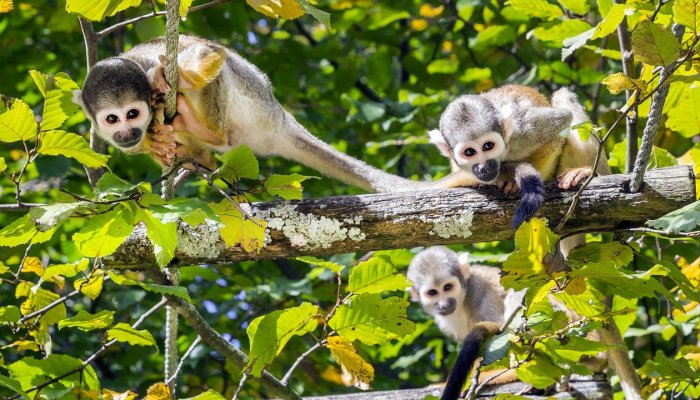
Animals of Ecuador
Birds
Ecuador has the world's highest density of bird species with more than 1,600 species, a delight for all the visitors who will find them without searching, and who can see diverse birdlife in the different regions. Some of the most famous are the majestic Andean Condor in the mountain regions, the Andean Cock-of-the-Rock which may be the national bird of Peru but which is commonly seen in Ecuador's cloud forests, the Hoatzin who can barely fly but has claws on their wings to clim trees, the Cloud Forest Pygmy-Owl found in the cloud forests, the Emerald-Bellied Woodnymph hummingbird with its stunning bright green and violet-blue plumage, and the Plate-Billed Mountain-Toucan, one of Ecuador's most emblematic and spectacular birds with their distinguished looking bill.
Mammals
There are around 360 species of mammals in Ecuador, including 130 species of bats, 20 species of primates and 30 endemic mammals. Amongst them are the Olinguito, discovered only 2013 and ressembling a mix between a teddy bear and a cat, the Spectacled Bear (the only South-American bear) who lives in the tropical Andes, the famous Three-Toed Sloth, the Ecuadorian Mantled Howler Monkey known for their vocals which can be heard over 3 miles away at dawn and dusk, the Andean Fox also known as Culpeo, the shy Brazilian Tapir who likes to live near water to hide when needed, and the Vampire Bat, Ecuador's best known bat specie.
Fish & Marine Life
Ecuador counts around 450 species of fish in its Pacific waters, and 800 in its rivers, including the famous Piranha who, unlike common belief, only feed on humans once they are dead or may be attracted to human blood, the Electric Eel which contrarily to its name is not really an eel but a catfish but which can produce an electric charge of up to 600 volts, the incredibly aggressive Payara (Vampire Fish) with its 6 inch long teeth, the giant carnivorous Arapaima Gigas which can grow over 3 meters in length and is covered in armored scales, and the small but terrifying Candiru which have the ability to fling themselves up urethras of those urinating in the Amazon river systems.
The harsh habitat of the Amazon basin is home to marine mammals unique to the area, such as the Amazon River Dolphin, also known as the pink river dolphin or the boto, which can reach up to 3 meters with colours ranging from rosy pink to gray-pink and a long snout, the rarely seen Amazonian Manatee who lives in wetlands and swamps, and the South American Otter, the world's largest otter with its 6 feet and 75 pounds who agressively defend their territory.
Reptiles & Amphibians
Ecuador's warm tropical climate is the perfect home for reptiles and amphibians. It is home to 350 species of reptiles including 210 species of snakes and 20 species of turtles, and to 460 species of amphibians (10% of the world's known species).
The best known reptiles are the Green Anaconda, the largest snake on Earth, who lives in the watery areas of the Amazon, the Boa Constrictor with colours ranging from red to yellow, tan, green or patterned, the Basilisk, a small green lizard related to iguanas, the American Crocodile, the largest of the world's crocodiles, the Black Caiman and Spectacled Caiman, the Giant South American River Turtle which lives in the Amazon river, and the South American Yellow-Footed Tortoise which carry yellow and orange scales on their front legs and live in rain forests.
Amongst the amphibians are the Mutable Rain frog with its thorn-like spines and which was only discovered in 2006, the multicolored Pinocchio Rainfrog with its distinctive snout, the Rio Pescado Stubfoot Toad also known as the Harlequin Toad due to its black speckles over a greenish yellow body, the Gralarias Glass Frog with its transparent skin living in the rain forests and only recently discovered, and 55 species of Ecuadorian Poison Dart Frogs, all vibrantly coloured and very toxic skin from which is extracted poison.
Animals of Galápagos
The Galápagos islands are home mainly to birds, reptiles and sea life, its isolation and distance from continents having made it difficult for mammals to find their way there.
Birds
Many species are found on the islands, including the distinctive Blue-Footed Boobies found on Española and Seymour easily recognized by their bright blue feet, the white and black feathered Red-Footed Boobies with red feet and blue beak, the Nazca Boobies which can be found on Genovesa, Española and sometimes San Cristóbal, the Galápagos Penguin whose ancestors originally come from Antarctica, the Flightless Cormorant with stunted wings and webbed feet, the largely aerial Galápagos Frigatebird with its broad wingspan and giant red gular sac that the males inflate during the mating season, the Galápagos Greater Flamingo which is the most vividly colored flamingo in the world, the Galápagos Waved Albatross (the largest of the Galápagos birds), the endemic and endangered Lava Gull, 13 species of Galápagos/Darwin's Finches, the diurnal Galápagos Hawk, and the fearless Española/Hood Mockingbird which drink blood from wounded sea lions in the dry season.
Fish, Sharks, Rays & Intertidal Life
To scuba divers and snorkelers' delight, the surrounding sea is inhabited by about 550 species of tropical fish, 13.6% of which are endemic, almost 30 species of sharks, and many species of rays.
One of the most common fish is the Pacific Creole Fish with its 3 to 5 distinctive dark or white spot on its coppery-red back, you may also see the carnivorous Red-Lipped Batfish which, as its name suggests, has bright red lips and a laterally compressed body ressembling that of a bat, and which uses its fins as legs to walk on the sea floor. Another common sight is that of the oddly shaped Mola Mola (Ocean Sunfish), the world's largest bony fish which are often seen around the northern shores of Fernandina and Punta Vicente Roca.
The presence of so many sharks around the Galápagos islands are proof of a healthy ecosystem. Some of the most prominent are the scalloped hammerheads, whale sharks, horn sharks, whitetip and blacktip reef sharks, tiger sharks, Port Jackson sharks, Galapagos sharks, and the giant Whale Shark routinely passing through, mostly around Wolf and Darwin Islands.
Many species of rays live in The Galapagos, amongst which Golden rays which enjoy quiet lagoons, Spotted Eagle rays easily recognisable with their distinctive white spots on their black tops, Stingrays and the large Manta rays measuring 13 ft across its wings.
With so much coastline, the Galápagos have around 40 square kilometers of intertidal coastal zone, home to many invertebrates such as sea urchins and sea cucumbers, sponges, sea anemones, starfish, and cnidarians such as gorgonians, corals, and many species of crabs. You will undoubtedly see the very colourful red, blue and yellow Sally Lightfoot Crab, also known as the red lava crab, as they very abundant throughout the islands, the endemic Galápagos Hermit Crab finding home in empty shells of other mollusks, or the Ghost Crab which blends into the sand with its pale-colored shell.
Sea Lions and Fur Seals
Sea lions and fur seals are some of the friendliest animals of the Galápagos, and they always make good photos.
You will find the Galápagos Sea Lion very easily as they gather en masse on beaches and shorelines of all the islands. They are playful and inquisitive, and are the largest animals on the islands, with males growing up to 550 lbs. Pups are born between May and December.
The Galápagos Fur Seal is actually a specie of sea lions, but are much smaller, and with shorter heads with large eyes and ears, and a thick fur coat. They much prefer shaded areas in order to keep cool. They can be found on Santiago's James Bay and Genovesa Island's Darwin Bay.
Whales
Whales and dolphins enjoy the western waters of the archipelago, most especially the region between Isabela and Fernandina due to the Cromwell Current's upwelling. Orcas, Common and Bottlenose Dolphins, and Bryde's and Sperm Whales can be see throughout the year. Other species which can be seen seasonally, when they travel from the north down to warmer waters are Humpacks, Minkes, Seis and Blue Whales.
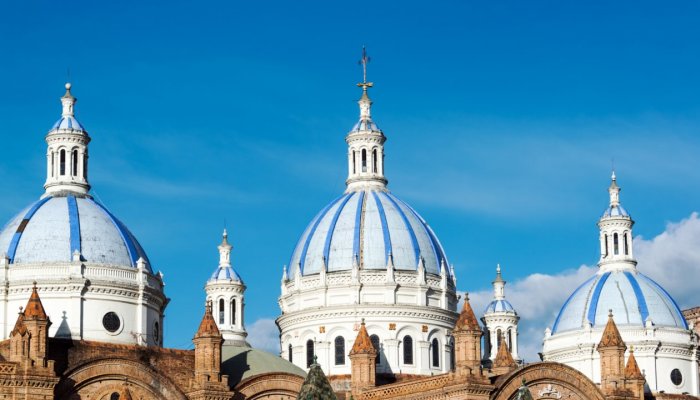
Culture of Ecuador
The culture of Ecuador as diverse and very unique, with a blend of cultures, and with the indigenous and mestizo populations preserving their traditional customs to this day.
Ecuador's Indigenous Cultural Heritage
Five separate ethnic identities are present in Ecuador: Mestizos (70% of the population), Indigenous peoples (7%), Afro-Ecuadorian (7%), Montubio (7%), and White. Much of Ecuador's rich heritage, including traditional dress, shamanistic practices and the Quechuan language come from the 13 indigenous groups.
The Huaorani tribe has lived in the Amazonian rainforest for more than a thousand years and remained isolated from the rest of the world until 1956, being self-sufficient, and developing a unique culture and language which defies all linguistic classification. Since they came into contact with the modern world when oil companies started encroching on their territory, some were relocated to missions by the government and started embracing ecotourism, while others receded deeper into the rainforest to continue to live as they always have.
Afro-Ecuadorians
Since their forced introduction to Ecuador during the Spanish conquest, Afro-Ecuadorians have often been marginalized. The majority of them live in the northwest of Ecuador, in the coastal province of Esmeraldas, which has helped foster their cultural heritage and customs. However, their musical talents and domination of Ecuadorian sports have significantly impacted the Ecuadorian culture.
Ecuadorian Cuisine
Ecuadorian cuisine is delicious, containing a lot of pork, cheese, yuca, plantains, fresh fruits and very varied according to regions. In the mountainous regions, the cuisine is richer and contains a lot of potatoes, corn, avocado and cheese. In the coastal regions, in addition to sea food, the use of coconut and rice are more common. The national dish of Ecuador is ceviche, an assortment of sea food marinated in lime juice and salt, and cuy (guinea-pig) is a delicacy reserved for special occasions. The Amazon cuisine is more exotic, using many local exotic fruits found nowhere else, and meat from turtles, monkeys, giant ants, snakes and chonta worms. With so many exotic fruits to choose from, Ecuador's fresh fruit juices are a delight and a bit part of Ecuadorians' lives. They can be served pure or mixed with milk.
Traditional Clothing and Dress of Ecuador
Native traditional dress is important to Ecuadorians, and shows their cultural diversity. The indigenous Otavaleños are easily recognizable with men sporting a long braid called the shimba, wearing white calf-lenght trousers, a blue poncho and a felt hat, and women dressing similarly, but with colors inversed.
In the Highlands, women usually wear brightly colored full pleated skirts with embroidery on the hem.
In the Amazon rainforest, several indigenous tribes still wear traditional feathered headdresses.
On the Ecuadorian Coast, people dress in a more modern fashion, but the Montubio people can be recognized by their wearing of sombreros and cowboy-style hats, while the Tsáchila can still be found to dye their hair red, and wearing distinctive striped clothing, dark and white striped skirts for men, and brightly coloured with stripes for women.
Headhunters
Many cultures worldwide have practiced headhunting, but the Jivaro are the only ethnic group known to shrink the heads of their enemies, a practice known as tsantsa. The aim of this practice, which includes skinning the head, discarding the skull and remains, boiling the flesh, sewing the eyes and mouth shut, and sealing hot pebbles and sand into the head, was to also kill the soul of their victim, as well as their body.
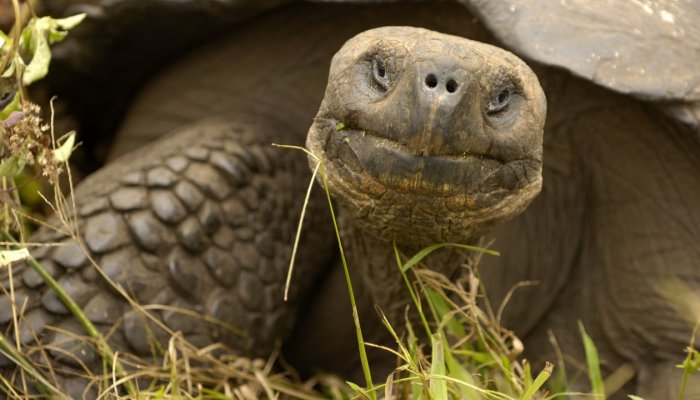
Conservation in Ecuador & Galápagos
Ecuador Conservation Challenges and Combattive Efforts
Ecuador is very rich in biodiversity, and supports 14 nature reserves, 11 national parks, a wildlife refuge and various natural heritage sites. However, as the country largely depends on bananas and oil exports, which necessitate environmental fragmentation, it struggles in finding a balance between its economy and ecology. In recent years Ecuador made the difficult choice of exploiting the masses of oil sitting underneath the Amazon rainforest. This brought many protests, most of all from the indigenous groups.
There were success stories: in 2013, 47,500 acres of rainforest entered the Chai Nunka Reserve, a victory from the Socio Bosque Program. And in 2015 Ecuador broke the world record for reforestation as thousands of Ecuadorians helped plant 647,250 trees and 216 plant species in 150 locations throughout Ecuador, as part of a long-term goal to eventually reforest 500,000 hectares of land, which would zero out Ecuador's current deforestation rate.
Galápagos Conservation Challenges and Combattive Efforts
The biggest threat to the endemic animals of Galápagos are the species introduced as far back as 1535, mice and rats at first, and later domestic animals brought in by settlers. Rats have destroyed hatchlings of giant tortoises, feral pigs fed on green turtle eggs, feral dogs attacked colonies of land iguanas, and goats decimated many of the endemic plants. Thankfully 95% of the Galápagos' native species have managed to survive.
The Ecuadorian government has made a lot of efforts to remove invasive species, with projects working on eradicating goats, donkeys, pigs, fire ants, baltra cat from some of the islands. Next on the conservation list is the eradication of cattle, burros, rodents, the fresh water tilapia, and the sterilization of dogs and cats.
97% of the Galápagos' landmass is a protected national park. In 2016 Ecuador announced the creation of a marine sanctuary of 15,000 square miles, meaning that one third of the Galápagos waters are protected.

Flora of Ecuador
Ecuador is home to more than 10% of the world's plant species, most of which (10,000 species) grow in the Andes in the northwest of the country, followed by the Amazon (8,200 species), many of which are endemic.
Mangrove Swamps
River deltas and tidal zones of bays and coasts are home to mangrove trees which can grow up to 30 meters tall in San Lorenzo, in northern Esmeraldas.
Coastal Desert
Arid scrub vegetation and cacti grow in the dry and arid coast of southwestern Ecuador.
Ecuador's Coastal Lowlands and Central Coastal Plain
Ecuador's coastal lowlands feature deciduous forests and savanna regions in which Bombacaceae trees, Mimosaceae trees and Rain trees are some of the most common sights, all growing between 60 and 80 meters tall, with wide canopies.
Much of the flora of the coastal lowlands has been cleared for agriculture. Only two species of palm trees remain: the canopy Royal palm or chivila, and the Ecuadorian Ivory palm endemic to western Ecuador, both species being important for the economy of the region.
Lowland Rainforest of Northwestern Ecuador
Ecuador's rainforest has an amazing biodiversity and an abundance of plant species, new ones constantly being discovered, mostly vascular plants, cacti, ferns, orchids, bromeliads, and trees including the Euterpe Precatoria palm, the giant Ceiba tree or Kapok tree which can reach up to 200 feet, growing more than 13 feet per year, and the Naranjilla tree covered with thorns and purple flowers which gives small oranges with green juice. Several varieties of vines and lianas grow on trees, sometimes strangling them or hanging off them. As a way to protect themselves, many plants are covered in thorns or secrete harmful toxins or simply taste terrible. Bromeliads form little ecosystems of their own, their leaves forming a bowl that catches rainwater and nutrients, which in turn make a perfect home for up to 250 species, including snails and treefrogs.
Cloud Forests
The cloud forests are found on the western and eastern sides of the Andes, and are lush, green, cool and moist, making it a perfect home for mosses which grow on tree trunks, ferns, algae on leaves, and over 4,200 species of very unique, beautiful and exotic orchids including the Monkey Faced orchid and the nameless world's smallest orchid at just over 2 millimeters wide with transparent petals.
Páramo
Above the cloud forests and below the snow caps, is the páramo, a scrubland that dominates the Andes. Hard grasses, cushion plants, small herbaceous plants and small trees live in this harsh environment including the Espeletia with wide rosettes and yellow daisy-like flowers and the endangered Polylepsis trees.
Flora of the Galápagos
Around 600 native and 825 introduced species grow on the Galápagos islands, 35% of which are endemic.
Littoral/Coastal Zone
The main vegetation in these regions are four mangrove trees species with populate the lagoons. They are important in protecting the coastline from erosion and also in providing protection for nesting sites of many bird species.
Arid Zone
The Arid Zone is the largest vegetation zone on the islands and is home to three types of endemic cacti: the candelabra cactus, the lava cactus, and the prickly pear cactus which is the primary diet of Giant tortoises and land ignuanas. Other plant species found in this zone are the Floreana Daisy, Galápagos lantana, Manzanillo, Muyuyo, Palo verde, Grey matplant and the Galápagos purslane.
Transition Zone
This zone transitions from the arid zones to the cool moist highlands, including vegetation from both. Small shrubs and trees in this area include the iconic Pega Pega and Hardwood Matazarno, both of which are endemic. Other common vegetation includes the Guayabillo, the Passion flower and the Galápagos tomato.
Scalesia Zone
This zone is found betwen in heights of 650 to 1300 feet, in the larger islands. Due to its altitude, it is more moist, and therefore more lush and cooler. The most famous trees in that region are the Scalesia trees which can grow to 60 feet and are covered with moisture loving vegetation such as mosses, ferns and orchids.
Zanthoxylum or Brown Zone
The main vegetation in this area are the Zanthoxylum Fagara or "cat's claw", and the brown lichens which grow on trees and form a brown carpet on the ground, giving the zone its name.
Miconia Zone
This zone, found only on San Cristóbal and Santa Cruz at 3,200 feet high, is named after the Miconia Robinsoniana shrub, the most endangered plant on the Galápagos, with pink and purple flowers and reaching up to 16 feet in height. A common sight in this zone is the Galápagos Cotton plant.
Pampa or Fern-Sedge Zone
This zone is found in the highest zones of the Galápagos islands. It is lush and green and home to grasses, ferns, mosses, lichens, orchids including the Galápagos orchid and the Galápagos Peperomia.
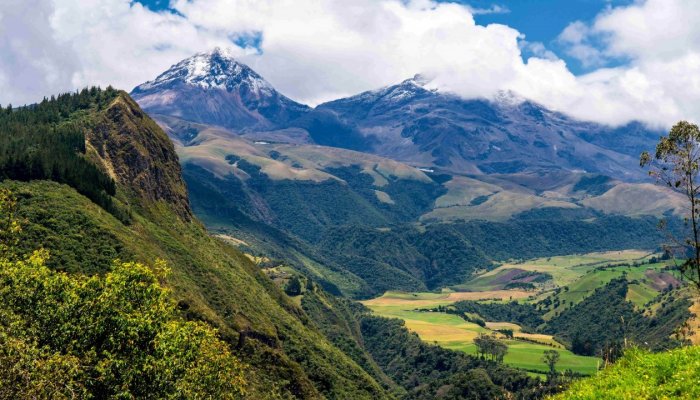
Geography of Ecuador
Ecuador is one of South America's smallest countries, situated on the equator, with 276,000 square kilometers of land on the continent and 8,000 on the Galápagos islands. It has three distinct types of terrain: the Sierra, the Oriente, and the Costa due to two parallel mountain ranges of the Andes spanning north to south.
La Costa
This coastal region along the Pacific Ocean on the west of the country is varied in composition, including jungle, mangrove forests, white sand beaches, fishing villages, and cities, such as Guayaquil which is also Ecuador's primary port. La Costa enjoys a cool sea mist from June to November, but overall a mild climate.
La Sierra
La Sierra is situated in the Andes, and it is comprised of active volcanoes, crater lakes, hot springs, cloud forests and moorland. There are two major chains of the Andes: the Cordilla Occidental and the Cordilla Oriental, in the valleys of which are grown wheat, corn, barley and quinoa. This part of Ecuador draws in more tourist than any other, with a wealth of outdoors activities available. There are heavier rainfalls from October to May, and it is dryer from June to September.
La Oriente
The Oriente region covers half of Ecuador, extending from the eastern borders of the Andes to and including the Amazon jungle, to the borders of Peru and Colombia. Although there are jungle tours to explore the rainforest, it does remain rather impenetrable in most areas. The climate in this part of Ecuador is tropical.
Geography of the Galápagos
The Galapagos islands are situated 600 miles from Ecuador's coastline on the South American continent. The archipelago comprises 13 large islands, 6 smaller ones, some islets, and has a land area of 7882 square kilometers. The Marine Reserve spans around 53,282 Square miles of Pacific Ocean.
Isabella is the largest island, with its highest point of 5,600 feet being the Wolf Volcano, right on the equator.
Population
The Galápagos is one of the few locations in the world without a native population.
The population of 30,000, a mix od Ecuadorians, Spanish descendants, Americans and more, lives on four islands, Santa Cruz's Puerto Ayora being the largest town.
Galápagos Ocean Currents
The biodiversity of the Galápagos is due to three ocean currents converging: The South-Equatorial surface water current, the Peruvian/Humboldt current, and the Cromwell Equatorial Sub current.
Galápagos Marine Reserve
It incorporates 133,000 square kilometers of sea surface between the islands, including inland waters, as well as the area within 40 nautical miles stretching out from the outer islands' coasts.
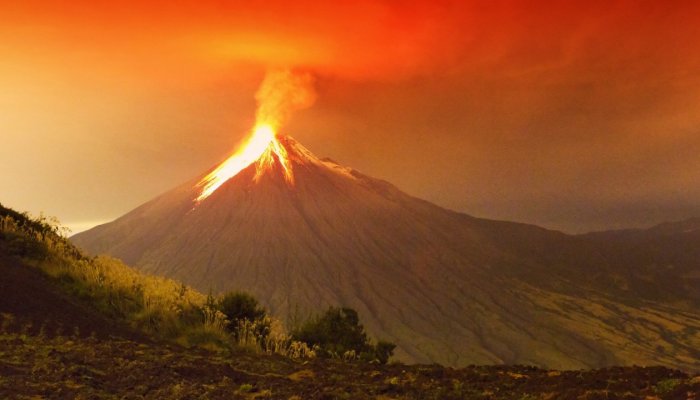
Geology of Ecuador
Geologic History
It is estimated that South America and Africa were joined until 150 million years ago, before starting to split. Over time, the South American plate collided with the Pacific plates, resulting in the uplift and formation of the Andes mountain range which runs all along the west of South America.
Geologic Composition
The country is sectioned in three parts by two Cordilleras of the Andes traversing it, the Cordillera Occidental at the West and the Cordillera Real in the East, with more reachable peaks than anywhere else in South America.
The Cordillera Occidental was created when the Pacific Ocean's floor met and uplifted against the Cordillera Real. Three impressive volcanoes are found on the Cordillera Occidental: Quicocha, Pululahua, and Quilotoa.
The elevated continental Napo Uplift block, responsible for much of the volcanic activity in Ecuador, and with two additional volcanoes, is an autonomous tectonic feature from the two other cordillera. The Reventador volcano is the eastern most active vocano. The Sumaco volcano, being an alkaline volcano, differs in lava composition.
The Avenue of Volcanoes
"The Avenue of the Volcanoes" was named after the fourteen impressive volcanoes found within an area of 200 kilometers in the Ecuadorian Sierra. They include Cotopaxi, the world's highest active volcano, which stands at 5,897 meters high, Volcán Cayambe with two lava domes formed on top of an extinct volcano, Tungurahua characterised by its ash explosions, Chimborazo the highest peak in Ecuador at 6,268 meters, and Pichincha with two volcanoes including a stratovolcano which lies only 9 km west of Quito which last erupted in 2008.
Geology of the Galápagos
The Galápagos have never been part of the South American continent, but they are affected by the same geologic forces.
The Nazca tectonic plate moves at the speedy rate of 6 to 8 cm per year and play an important role in the growing of the islands of the volcanic hotspot of the Galápagos archipelago. Under water volcanoes form through cracks in the plate and grow until they reach the ocean surface. As the tectonic plate keeps shifting, new cracks appear, forming new volcanoes, creating in time a chain of volcanic islands. The oldest island of the Galápagos can be found on the east of the archipelago, while the youngest is on the west, with younger volcanoes lieing further east still, not having yet reached the ocean surface and formed islands.
Galápagos Volcanoes
Most of the volcanoes on the Galápagos are rounded shield volcanoes. Lava erupts from vents and cracks on the structure, and the outflow create smaller parasitic cones. Visitors will often see black hardened lava fields, mainly on Santiago's Sullivan Bay, and lava tunnels and pit craters in the Santa Cruz Highlands.
Recent Eruptions
60 eruptions have been recorded since the archipelago was discovere in 1535, but only 6 volcanoes remain active today, 5 of which are on Isabela, and one on Fernandina. The most recent eruptions have been in 2005 and 2009 on Fernandina island, and in 2008 on Isabela island.
Travel Essentials
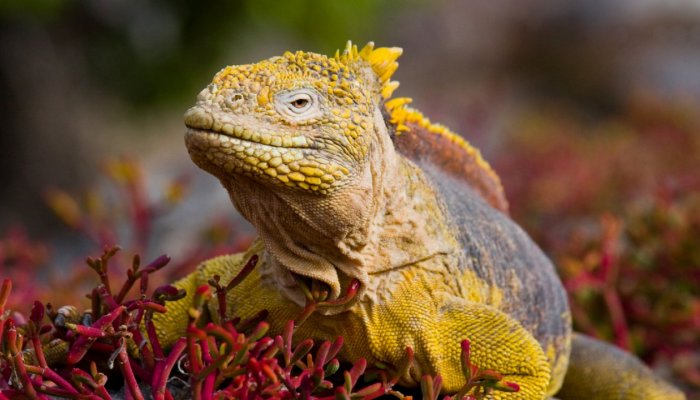
Money in Ecuador and Galápagos
Currency
The official currency in Ecuador if the U.S. dollar, with no restrictions for entry or exit. However $100 bills are not accepted by banks or shops, and it is recommended to come with $20 bills or less as small shops rarely have large bills to give change.
ATMs and Credit Cards
ATMs can be found in the Galápagos but aren't plentiful, and non existant on some of the islands. We advise researching ATM locations before you leave, as well as fees for international transactions.
ATMs are available in all major cities of Ecuador, and many locals accept Visa, Master Card, American Express, and Diner’s Club being the most widely accepted. We recommended carrying both US bills and traveler’s checks while visiting Ecuador, and exchanging them in Quito, Cuenca, or Guayaquil.
Tipping
It is customary to tip restaurant staff and naturalist guides and boat staff on the Galápagos, at your discretion.
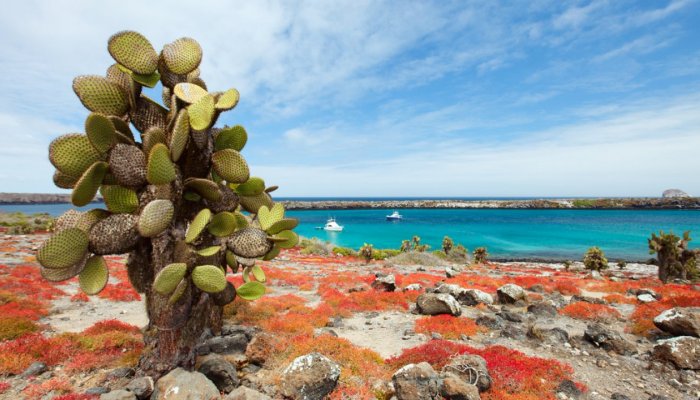
Health & Safety in Ecuador and Galápagos
Health & Vaccinations
For travels only to Quito and the Galápagos islands, no vaccinations are required. If you plan on visiting other parts of Ecuador, in particular the Amazon or coastal regions, get advice from your doctor about recommended vaccinations 4 to 6 weeks prior to travel.
The Center for Disease Control advises on being inoculated against measles-mumps-rubella (MMR), diphtheria-tetanus-pertussis, polio, varicella (chickenpox), the flu, and up-to-date with routine vaccinations.
If visiting the Galápagos, we recommend bringing seasickness medication with you if you are susceptible to motion sickness.
Travel Insurance
We recommend taking our a travel insurance policy to protect you against theft, loss, and injury, however you may have to research one that also covers activities listed as "Dangerous activities" as many don't.
We recommend keeping receipts of all medical treatments and obtaining a statement from the police, in case you ever need to make a claim of loss.
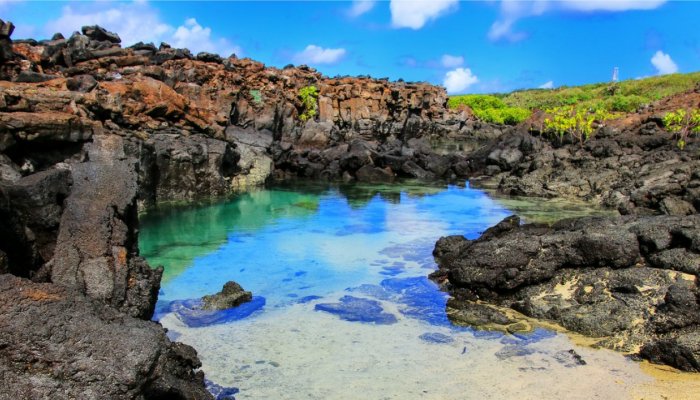
Entry Requirements to Ecuador and Galápagos
Visas
U.S. citizens do not need a visa for stays of 90 days or less. If travelling to the Galápagos, U.S. citizens need a valid passport with expiry date at least 6 months after your expected return to the U.S., a return ticket, and proof of economic means of support.
Customs in Ecuador
Most visitors to the Galápagos travel by plane from Ecuador. At the airport, visitors are required to have bags inspected by a quarantine staff and acquire a requisite tourist Transit Control Card for a nominal fee, to ensure no non-native fauna or flora are brought to the islands.
Galápagos Flight Regulations
Visitors may bring 1-2 pieces of luggage weighing no more than 44lbs in total and one carry-on bag weighing no more than 17lbs. Excess baggage will incur an additional charge.
Galápagos Park Regulations, Fees and Rules
Upon arrival in the Galápagos Islands, visitors pay a mandatory entrance fee in cash to the Galápagos National Park. Currently, the fee is $100 for non-Ecuadorian adults and $50 for non-Ecuadorian children.
In an effort to conserve the Galápagos Islands’ fragile ecosystem, the Galápagos National Park Service established park rules for its visitors. We recommend familiarising yourself with them, to ensure you leave no trace behind in the Galápagos Islands.

In the Galápagos
Phones
Large, inhabited islands have cell service. However, travelers must activate global roaming with their provider, which can be expensive.
Internet
Some hotels and restaurants provide wi-fi, and some internet cafés can be found in Puerto Ayora on Santa Cruz and Puerto Bquerizo on San Cristóbal Island, but Internet service is generally scarce throughout the Galápagos Islands.
On Mainland Ecuador
Phones
Public phones are now disappearing in Ecuador, but the use of mobile phones is widespread. You will need a GSM (Global System for Mobiles) phone activited for global roaming if you bring your own phone, but the charges per minute can be high. The best option is to buy a prepaid SIM card in one of Ecuador's main cellphone networks. Another option is to buy an activated phone with pre-paid minutes on it at a local store or major airport. Ecuador's main cellphone companies are Porta, Movistar, and Alegro.
Internet
WiFi is widespread in Ecuador, it is not always free or fast but you generally can find access, especially in Guayaquil or Quito. Internet cafes are however fast disappearing.
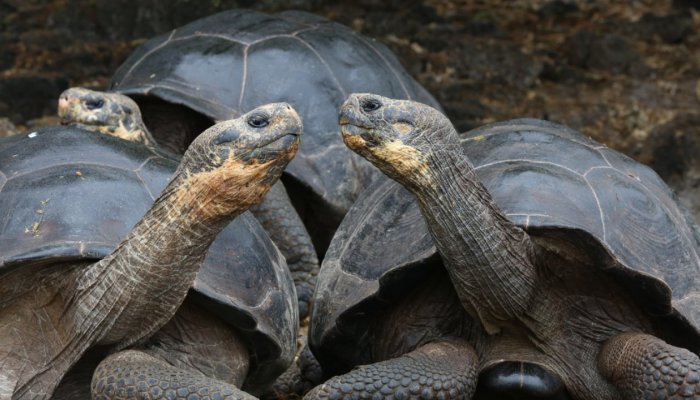
Power in Ecuador and Galápagos
Type A and B power sockets can be found in the Galápagos Islands and mainland Ecuador, though the majority are two-pronged wall sockets. The standard voltage is 110V with a standard frequency of 60HZ.
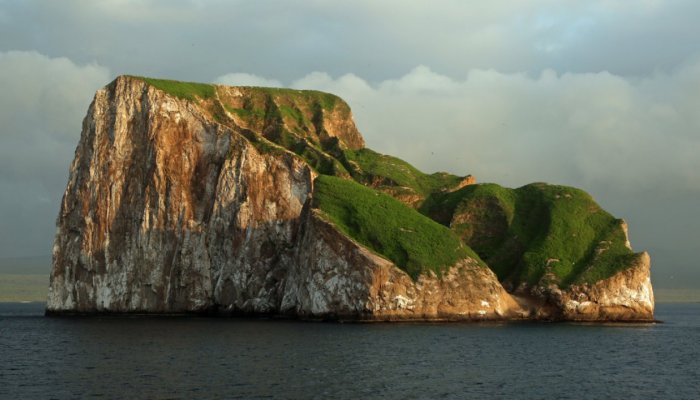
Flying to Mainland Ecuador
There are two international airports in Ecuador, in Quito and Guayaquil. It is easy to find connecting flights from either one to major hubs. If you travel from the United States, there are regular flights from Miami, Houston and Atlanta, from which the flight time is only 4 to 5 hours.
Ticket prices are higher from June to September and from December to January.
Flying to the Galápagos
There are two airports on the Galápagos: Isla Baltra and Isla San Cristóbal, both of which have flights from Quito and Guayaquil on mainland Ecuador with the TAME, Avianca and LAN-Ecuador airlines. There is a 20kg/44lb limit per person on checked luggage with all three airlines.
Related Blogs
Meet Our Guides
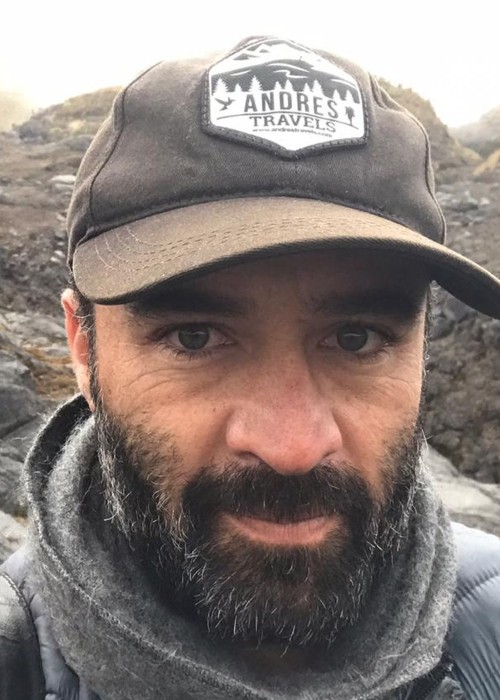
Andrés Trujillo
Galapagos Sea Kayak Guide
Andres Trujillo is a world-renowned professional naturalist from Bogota, Colombia. He is currently living in Quito, Ecuador. He is passionate about wildlife, forests, oceans, music, and sharing conservation everywhere he travels. He focuses his efforts on creating memorable experiences for his clients in nature with local people in their natural environment. Andres is well known for his knowledge of wildlife and culture. His photography, people skills, and love for nature and adventure.
When he arrived from Colombia, he was raised in a humid rainforest in the northwest lowlands of Ecuador, where he fell in love with nature. After seeing the issue of deforestation as a child, he started spreading the word about sustainability and conservation, years after he studied ecology and ecotourism working in the Amazon rainforest, with nature and indigenous tribes, who played an important role for him to understand and to approach the issue of human development.
Sharing his love for wildlife photography, he can be a great companion for people who want to cover a country capturing special creatures or moments to take home. With his camera, binoculars, and all the equipment needed, he is able to share the world the best destinations for nature and adventure that Latin America has to offer.
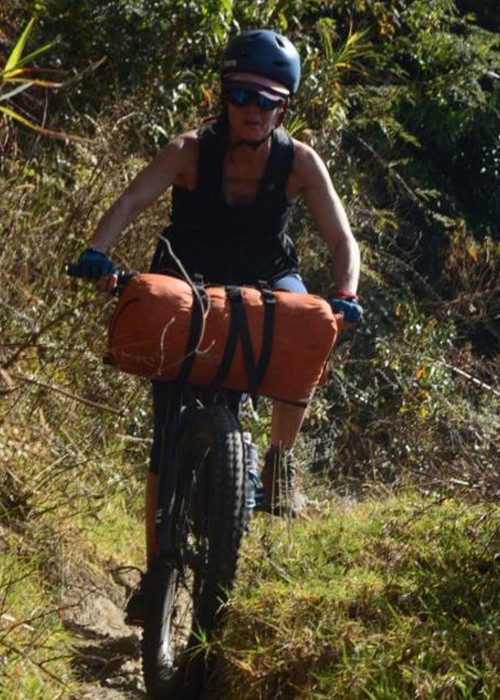
Nicole Marchan
Galapagos Adventure Guide
Nicole has a deep respect and knowledge of nature, its people, and their traditional ways. She is an avid naturalist, herbalist, yoga instructor, and adventure sports lover. She has been guiding for over 15 years, sharing her passion for Ecuador and the Galapagos Islands. She studied Biology and for many years worked with indigenous people in different conservation and sustainability projects. Nicole lives in small permaculture and sustainable farm and school in the heart of the Andes with her partner and her 9-year-old daughter.
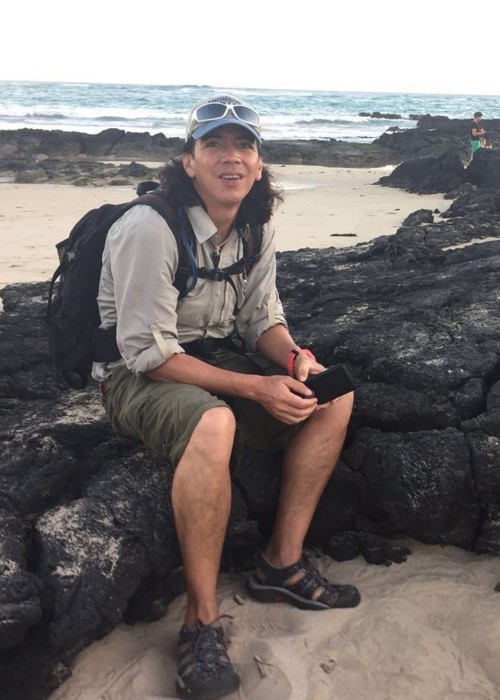
Sebastián Jurado
Galapagos Adventure Guide
After growing up in a small town in a valley of the Andes Mountains in Ecuador near the city of Quito, Sebastian decided to travel to Santiago de Chile to obtain a Bachelor’s Degree in Tourism Administration. His eagerness for travelling took him in a backpacking adventure through Canada and United States for 9 months. Having perfected his English he started guiding in Ecuador in 1998. As a young nature lover interested in natural history and ecology, nature filming, photography, alternative energy, ecotourism development, and outdoor sports his career took an interesting path. From guiding in Ecuador he was invited to manage a prestigious Environmental Education Project in Costa Rica and split his time between working in environmental education in Costa Rica and guiding in Ecuador for five years. Along with his love of nature he has always been fascinated by the cultural diversity of the Andes and in 2004 he began a Master’s Degree program in Social Sciences and Sustainable Development in Cusco, Peru where he also had the chance to lead tours to Manu National Park in the Amazon Basin. He came back to Ecuador to continue guiding and he was invited to be a project advisor for anthropology study abroad programs in Ecuador and in country liaison for Louisiana State University business students.
In 2007, Sebastian participated in the Wilderness Medicine Institute & American Heart Association and successfully completed the course of Wilderness First Aid and CPR. During the last years his experience sea kayaking has made him one of our main sea kayaking leaders in the Galapagos Islands. Due to his experience and knowledge we have him working with us in the development of new programs and training and coordinating guides when he is not guiding on the field. Sebastian has been part of our team since the beginning of his career and we are proud to count with him as part of our expert group of leaders.
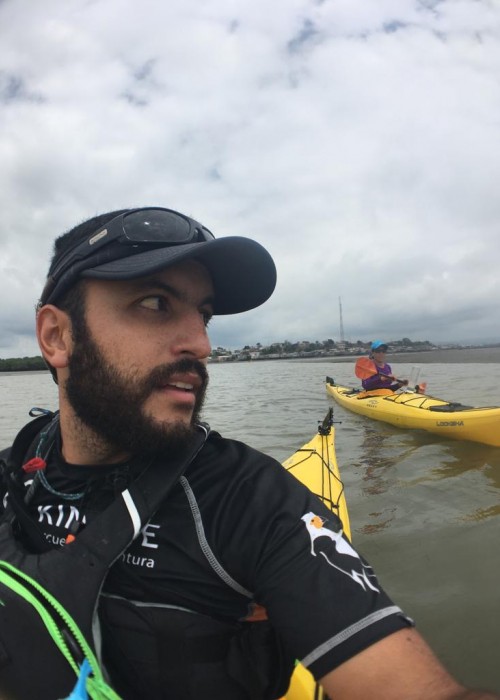
Ignacio (Nacho) Anhalzer
Galapagos Sea Kayak Guide
Ignacio, also known as Nacho, was born and raised in Ecuador. Has practiced all sorts of outdoor sports since an early age, from mountaineering to sea kayaking. This experience motivated him to obtain a degree in Sports Management from Bond University in Queensland Australia. He is currently a NOLS Instructor, WEMT and LNT Master Educator. Nacho has paddled in New Zealand, Patagonia, Denmark and tons in Ecuador. Nacho is WAFA certified since 2015. When he is not guiding, he is taking care of his own outdoor education company in mainland Ecuador.
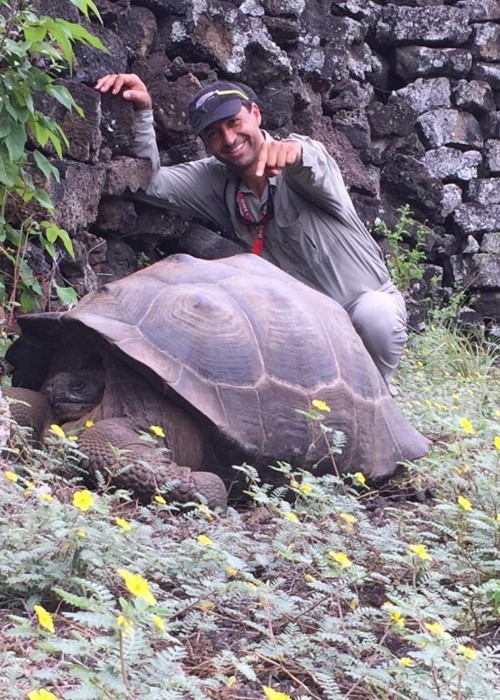
Marco Castro
Galapagos Adventure Guide
Marco was born in the highlands near Quito. His childhood was spent on the family farm with horses and cows to chase or mountains to hike. This kind of childhood fostered a love for the outdoors and taught him to enjoy time in nature.
Marco studied Tourism Administration to become a tour guide, allowing him to work outside while displaying his passion for the wonders of his native country, Ecuador. Hiking, horseback riding, bicycling and kayaking keep Marco feeling close to home while he's away guiding. Marco has been guiding people around the Highlands, Amazon basin, Coast, and Galapagos archipelago for over 20 years. He has learned to enjoy sharing with people, to accept them, understand their needs and make them feel like family while visiting his home country of Ecuador.

Tomás Palma
Galapagos Adventure Guide
Born in the city of Quito, Tomas had his first education in his hometown. With only 17 years of age he traveled to United States to perfect his English and acquired a taste for travelling. It was during this trip that he decided to go to school to study tourism back in Quito obtaining a bachelors degree in Tourist and Hotel Management, it was during this time that he perfected his English and Italian and obtained his National Tour Guide License issued by the Ministry of Tourism in 1993.
His passion for nature and geography as well as his outdoor spirit quickly gave him recognition as a tour guide in Ecuador, as he was invited to guide important groups of worldwide personalities brought by the Ministry of Commerce and the Galapagos Foundation to increase worldwide awareness of the vulnerability and need to preserve the Galapagos Archipelago.
He also has been the leader for well-known school groups such as Washington University and Stanford Alumni and families. In 2011 he was invited to an expedition in Alaska to train a crew of an important cruise company to lead family groups. Tomas has become one of the most recognized and experienced tour leaders in the country, due to his ability to accommodate each guests needs, good humor, positive attitude and immense knowledge of culture and nature. Nowadays he also runs a beautiful guesthouse in the Andes of Ecuador together with his wife Carolina where they plan to raise their 3 children.


